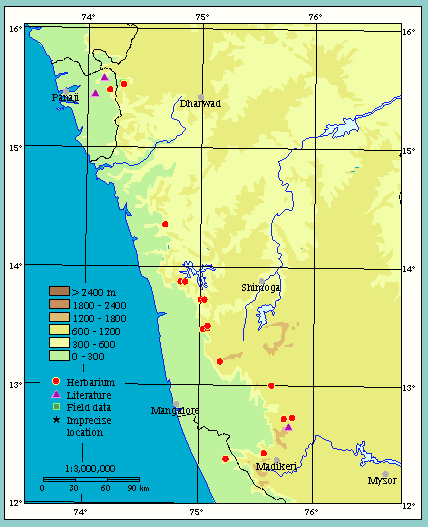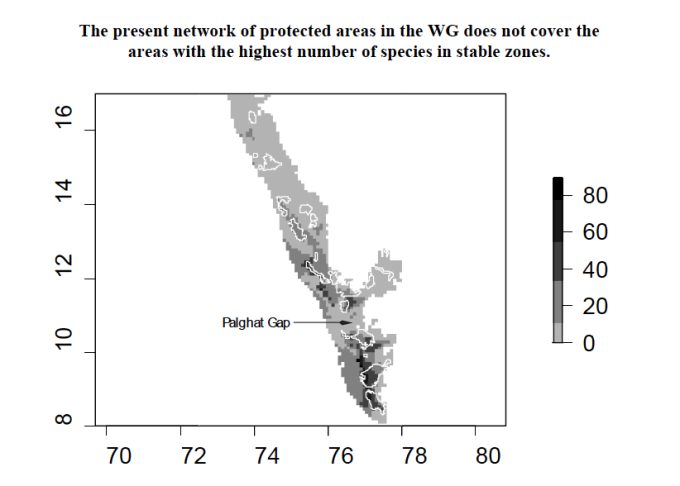The health of the water tank of peninsular India depends on the stability of its endemic tree species, according to a recent study

The health of forests in the Western Ghats will determine the flow of water in the peninsular rivers. (Image by S. Gopikrishna Warrier)
Even as a sapping drought sweeps across western Deccan Plateau in India, how the forests of the Western Ghats respond to climate change may show how much water the rivers originating in the mountain range carry to the plains. With most of the easterly rivers in southern India, including the Krishna and the Godavari, tracing their sources here, the Western Ghats is known as the overhead water tank of peninsular India. A river can viewed as a drainage channel and its water flow is as good as the health of the forests on the mountains where it originates.
To understand how an ecosystem will react when it is affected by climate change in the future, it is important to look into the past and see how it has coped with earlier changes in climatic conditions. It becomes that much more important when it deals with the endemic tree species of a global biodiversity hotspot such as the Western Ghats.
The endemics have their unique ecological niches, areas that have conditions that are congenial for the trees to grow. Studying how the ecological niches have responded to past changes in climate would throw light into how they are likely to respond to future climate change.
An analysis of the ecological niches into the past 150,000 years has helped a team of scientists at the Institut Français de Pondichéry (IFP) in Puducherry on India’s east coast to understand that the habitat for the endemic tree species has mostly remained stable over the period.
The time frame of 150,000 years corresponds to the present glacial cycle for the world, B.R. Ramesh, researcher at IFP, told www.idiaclimatedialogue.net. Three points of reference were chosen within this timeline. The Last Interglacial (LIG) – the warm period between two periods of glaciation – was between 125,000 to 150,000 years before the present. The Last Glacial Maxima (LGM) – when the world was cold and there was much ice on earth – at 20,000 years before the present was taken as the second milestone of assessment for the study. The third milestone chosen was the present day distribution of the ecological niches for the endemics.
Digital tree atlas
Ecologists at the IFP have carried out extensive field research on the endemics tree species of the Western Ghats since the 1970s. Using this knowledge base, they had created a digital atlas that is available online.
“From our database of endemics in the Western Ghats, we selected 200 species,” said Ramesh. “We modelled their distribution based on present-day bioclimatic variables. Through this modelling we determined the niche trajectory of each species, i.e., what is its bio-climate and what is its amplitude (ability to accommodate) to 19 variables. Among the variables, three were the most important – the west to east temperature and elevation gradient, north to south seasonality of climate and the rainfall gradient.”
By extrapolating the variables for each species over the current bio-climate profile of peninsular India, the IFP team was able to work out the boundaries of the habitats of each of these 200 species. This was like modelling where all the particular species can grow, even though it may not have many trees growing in the present.
After marking out the boundaries of the present-day habitats for each of the species, the team worked with models that reconstructed the bio-climate across Peninsular India in two points in the past – LGM and LIG. The affinities of each of the 200 species were juxtaposed on the LGM and LIG bio-climatic profiles to check what could have been boundaries for their habitat in the past.
Three trajectories
The team from IFP reported in a paper published in the Journal of Biogeography that three trajectories were observed for the Western Ghats endemics. “We identified three distinct scenarios of species’ responses to past climate changes – stability, contraction and shift – depending on their bioclimatic preferences,” they noted.
For species such as Diospyros saldanhae, the suitable habitat was more or less stable during all the three time periods. These species related to the stable scenario. The habitat for some other species contracted. For instance, the habitat for Goniothalamus wynaadensis was available in Sri Lanka and over wide tracts in the Western Ghats. This started contracting during the LGM, reducing even further in the present day. The suitable habitat has contracted now.

The habitat of Diospyros saldanhae have remained stable across millennia. (Map by Institut Français de Pondichéry )
The habitat for Gluta travancorica had migrated from Sri Lanka the southernmost part of the Western Ghats during the cold, dry years of the LGM, when the land bridge connecting the island nation to the Indian mainland was above water. So either this species or another species close to this one migrated to the southern Western Ghats. Now they are not found in Sri Lanka.
The results from the study indicate that the species with the most stable predicted distributions were those in the higher altitudes of the mountains; the mid-elevation species along the ridges had a contraction in their habitat; and the species in the southernmost tract migrated from outside.
The species with stable habitats were those that could survive on various elevation levels, thus could survive at lower altitudes of the mountains during the cold period of the LGM. The species that had contraction were those that could grow in various latitudes, which then moved into the safety of the middle-altitude ridges. The species that migrated from Sri Lanka are currently in the southern end of the Western Ghats – the Agasthyamalai Biosphere Reserve – where they were not present during the LIG.
High climate resilience
Overall, the Western Ghats provided a stable environment for its endemics in the past 150,000 years, according to the study. This is an indication of good climate resilience for the environment of the Ghats.
“We tried to understand how the species could move in space in the Western Ghats or resist changing environment locally,” said François Munoz, head of the ecology department at IFP. “Some species could be in the same place over a long time even if the environment has changed. If these species have a better ability to cope with the changing climate in the past they would have the same ability for the future.”
“We could identify spatially some parts of the Western Ghats that have had more stability over the changing climate. Because of their topographical features there would have been more sustainable rainfall over time and more species could persist. These areas were more stable for climate, and were also refuges for species. For conservation it is important to understand where there is more possibility of stability in the future and also more genetic diversity since these areas had accommodated more species over a long time.”
According to Munoz, the tropical evergreen forests of the Western Ghats are even different from similar forests in other parts of the world. It had lower reduction in area during the LGM – which was a dry period globally – because of the unique monsoon system of the Indian subcontinent. So the Western Ghats species may be different from other parts of the world because it did not face the same story of climate change. The Western Ghats was more stable.
“The Western Ghats is unique in the world for its ecologically specific context and also its endemism. The Western Ghats provide a very heterogeneous environment since it has a complex topography and a complex monsoon regime,” said Munoz.
“Even if we consider one parameter – the number of dry months – we realise that over a north-south axis on the Western Ghats it goes from six months to two months of dry period over a distance of 1,000 km. However, across an east to west axis, this gradation can come within seven km across the crest,” observed Ramesh. “So it becomes a cradle of speciation.”
Human interference
However, there is a catch. After the IFP team identified these stable areas, they realised that only 33% of them are covered within the protected area network (covered by wildlife sanctuaries and national parks). Two-thirds of these areas come outside the protected area network, and hence are more prone to human interference.

The present network of protected areas in the Western Ghats does not cover the areas with the highest number of species in stable zones. (Map by Institut Français de Pondichéry )
“The stable areas are natural gene reserves and thus it is very important to protect them,” said Ramesh. “These are the areas from where natural adaptation can come when the climate changes in the future. Increased human interference can make these areas more vulnerable to climate change.”
Ramesh spelt out the bottom-line: “If so many endemic species have survived in the Western Ghats over millennia, then it is due to the diversity of conditions it has provided. So, on the reverse, when the species disappear they can also increase the fragility of the environment.”
Extreme weather events such as the present drought are predicted to become more frequent and intense with the changing climate in the coming decades. The forests in the Western Ghats from which the rivers that can give succour originate, continue to be exposed to human activity. At risk of being lost is their ability to have withstood 150,000 years of changes in climate, something that can hopefully protect peninsular India from future climate shocks.

Great and informative article.